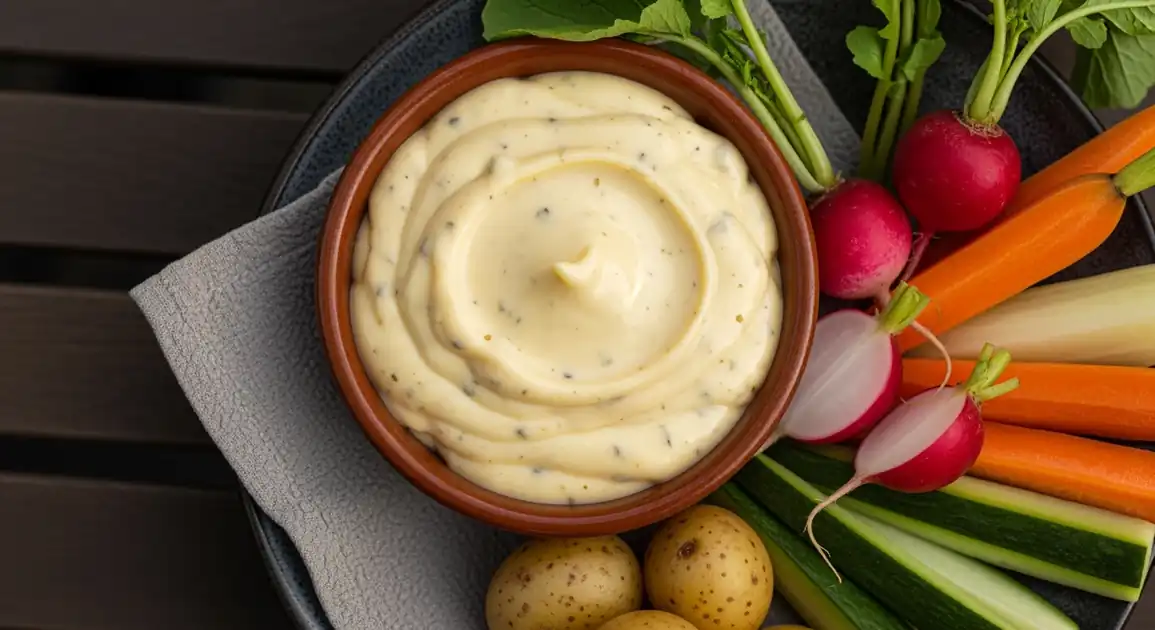Aioli
Aïoli

Description
Across France, aioli represents the sunny cuisine of Provence and the Mediterranean coast. While available nationwide, the most authentic versions are found in the south, particularly in Provence-Alpes-Côte d'Azur region. Traditional Friday 'Grand Aïoli' meals are still observed in some areas, celebrating the rich culinary heritage of southern France.
Dietary Information
Serving information
Serving style
Typically served in small ramekins as a condiment, or as the centerpiece of Grand Aïoli with various accompaniments arranged around a central bowl of the sauce. Often accompanied by crusty bread.
Quick facts
Markets: 8 AM - 1 PM. Restaurants: 12 PM - 2 PM for lunch, 7 PM - 10 PM for dinner.
Safety Tips
What to Look For
-
Freshly made aioli prepared same-day
Due to raw egg content, freshness is essential. Quality establishments make aioli daily.
-
Proper refrigeration
Aioli should be kept consistently chilled when not being served. Look for aioli served in chilled containers or with ice underneath.
-
Consistent, homogenous texture
Well-made aioli maintains a uniform texture. Separation indicates poor technique or old product.
-
Clean utensils provided for serving
To prevent cross-contamination, ensure fresh utensils are available, especially in communal dining settings.
-
Made with quality oils and fresh eggs
Ask if they use extra virgin olive oil and fresh eggs. Better ingredients make both safer and tastier aioli.
What to avoid
-
Aioli with separated layers or broken appearance
Separation indicates either poor preparation or, more concerning, that the emulsion has broken down over time due to age or improper storage.
-
Yellow or gray discoloration
Discoloration beyond the natural pale yellow suggests oxidation or spoilage.
-
Overly sour or 'off' smell
While aioli should smell of garlic, any sour or unpleasant odors suggest spoilage.
-
Room-temperature aioli that's been sitting out during service
Due to raw egg content, aioli shouldn't remain at room temperature for extended periods. Reputable places will keep it chilled.
-
Pre-packaged aioli with long shelf lives
These often contain preservatives and may not reflect authentic preparation methods. Fresh is always preferable.
Price information
Price range
Budget tips
- A small container of aioli from market vendors costs about 3-5 EUR.
- Restaurant aioli as a side or dip typically costs 4-6 EUR.
- A complete Grand Aïoli meal ranges from 14-18 EUR for a lunch service.
- Make the most of lunch menus ('formules midi') which often include traditional dishes at better prices.
Value indicators
- Made in-house ('fait maison').
- Uses local, high-quality olive oil.
- Freshly prepared that day.
- Served with generous accompaniments for Grand Aïoli.
- Proper consistency (thick enough to coat a spoon).
Where to Find This Dish
Traditional Markets
Food vendors at covered and open-air markets often sell freshly-made aioli.
Local farmer's markets, Covered markets
Morning, Early Afternoon
Provençal Restaurants
Traditional restaurants specializing in regional cuisine always offer aioli.
Restaurants displaying regional specialties, Places with 'Grand Aïoli' advertised
Lunch, Dinner
Seafood Restaurants
Often served with fish dishes or as part of seafood platters.
Harbor-side restaurants, Bouillabaisse specialists
Lunch, Dinner
Vendor Tips
- Ask if the aioli is 'fait maison' (homemade) rather than commercial.
- Inquire when it was prepared – fresh daily is ideal.
- For Grand Aïoli, Friday is traditionally when it's featured and likely to be freshest.
How to Order
Regional Variations
-
Traditional Provençal Aioli
(Aïoli Provençal Traditionnel)
The classic preparation made with garlic, egg yolks, olive oil, and lemon juice, often using a mortar and pestle. This is the foundation for the Grand Aïoli meal.
-
Saffron Aioli
(Aïoli au Safran)
Enhanced with saffron threads for a golden color and subtle aromatic flavor, commonly served alongside seafood dishes.
-
Rouille
(Rouille)
A close cousin to aioli that includes red pepper or paprika and sometimes bread soaked in stock. Traditionally served with bouillabaisse.
-
Herb Aioli
(Aïoli aux Herbes)
Incorporates fresh herbs like parsley, tarragon, or basil for a fragrant variation, popular in more contemporary Provençal cooking.
-
Lemon Aioli
(Aïoli au Citron)
Emphasizes the citrus component with additional lemon zest and juice, creating a brighter, more acidic profile.
Cultural context
History
Aioli's roots trace back centuries in Mediterranean culture, with historical records showing garlic-oil preparations in Roman times. The modern version from Provence evolved alongside similar garlic sauces from Spain (allioli) and Italy (agliata). Traditionally prepared in a mortar and pestle, aioli became a Friday staple in Provençal households, particularly in fishing communities where it accompanied salt cod. The dish symbolized both frugality and celebration, bringing families together for a simple yet satisfying meal that showcased local produce and the region's abundant garlic.
Local significance
Aioli represents Provençal cuisine's emphasis on simple, quality ingredients transformed through technique. The communal nature of Grand Aïoli embodies the region's convivial approach to dining.
Eating customs
- When enjoying Grand Aïoli, take small portions of the sauce rather than double-dipping.
- It's customary to try each component with the aioli individually.
- Use bread to clean your plate of remaining aioli at the end of the meal.